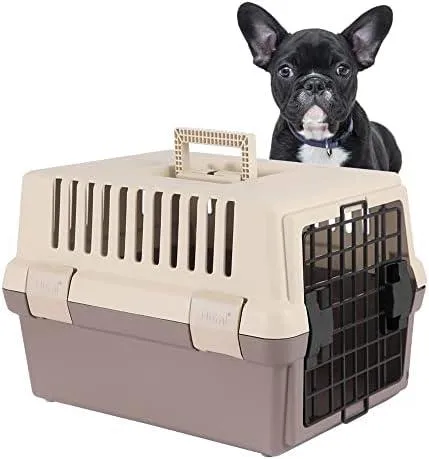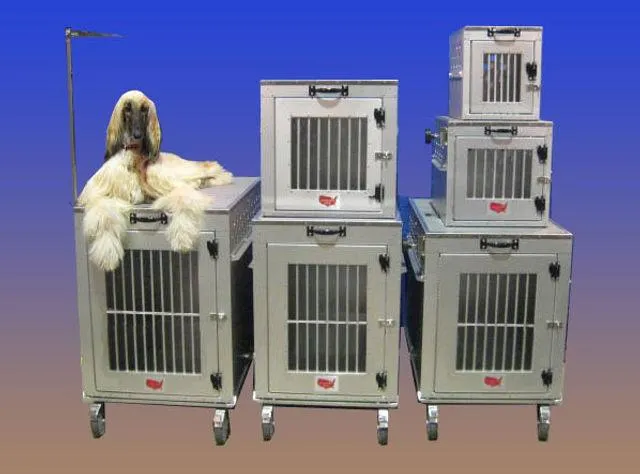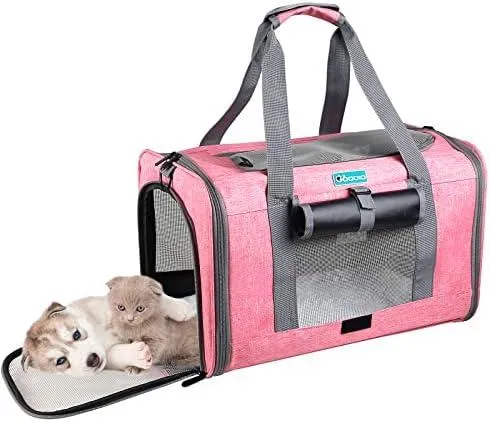Traveling with Your Dog? Everything You Need to Know About TSA Kennels
If you need to fly with your furry friend, using a TSA-approved kennel is essential for making the journey as stress-free as possible for you and your pup. Here are answers to common questions about TSA kennel requirements and tips from my experience traveling with dogs:
What Size Kennel Does My Dog Need?
- The kennel must be large enough for your dog to stand up, turn around, and lie down in a natural position.
- For most medium and large dog breeds, the kennel should allow about 8 inches of extra headroom above your dog’s head when standing.
Measure your dog and then check kennel dimensions. Travel kennels usually come in sizing ranges rather than single measurements to accommodate variations between individual dogs. Buy the next largest size if you’re between ranges to avoid cramping your pup.
What Materials Are Allowed?
The kennel must be made of a rigid material like plastic, metal, or fabric mesh. Collapsible soft-sided kennels and pillow-pet style carriers do not meet TSA guidelines as they are not considered fully enclosed. Wooden or cardboard kennels are also prohibited for lack of rigidity and potential crushability issues during baggage handling.
Does the Kennel Need to Be Labeled?
Yes, the outside of the kennel should be clearly labeled with your contact information in case it gets separated from you during travel. Use a permanent marker or adhesive label to note your name, phone number, and destination. This helps ensure your pup is promptly reunited with you if the kennel ends up in the wrong plane or airport.
Any Other Tips for Flying with Dogs?
Here are a few more suggestions based on my experiences:
– Make sure your dog is accustomed to using their kennel before travel day. Feed them in it and give treats so they see it as a safe, comfortable place rather than a punishment. A stressed dog is more likely to bark or have accidents.

– Consider anxiety medication or calming supplements if your dog tends to get anxious. Your vet can advise safe options.
– Bring water, a leash and poop bags, plus your dog’s favorite toy or bedding inside the kennel for comfort. Food is not recommended for takeoff/landing in case of upset stomach.
– Check with your airline for any other requirements around health certificates, vaccinations, or limits on small or very large dogs. Rules can vary between carriers.
– Allow extra time at check-in as you may have to show kennel dimensions or deal with any questions. Don’t cut it too close!
– Seat your dog under the seat in front of you if possible for a smaller carrier. But a larger, well-behaved dog may fly in the main cabin depending on the airline.
From my experience, an anxious dog can totally kill your vibe during a flight! But following TSA guidelines and these tips will help give your pup the best possible chance at being a calm flier. With some preparation, flying with Fido can go smoothly.

Other Common User Questions
Here are answers to a few other questions users often have when researching TSA dog kennel requirements:
Q: Can I travel with multiple dogs?
You can certainly bring more than one dog as long as each has its own properly-sized, approved kennel. However, be prepared for higher fares and luggage fees as extra kennels count as checked baggage. Cramming multiple large dogs into one kennel is a big no-no.
Q: Can I use a collapsible kennel as a personal item?
While smaller collapsible kennels may fit as a personal item onboard, the TSA explicitly requires dogs to be in hard-sided kennels as checked baggage for safety reasons. So no, you cannot fly with your dog in a soft carrier even if it meets size limits for the cabin. Always check the kennel in the plane’s cargo hold.
Q: Can I travel internationally with my dog?

Yes, but international regulations are more complex. You’ll need a veterinary health certificate, microchip or tattoo ID, proof of rabies vaccination, and sometimes a quarantine stay. Carefully research entry rules for your destination country well in advance. The paperwork slog is worth it see your pup’s reaction to snow or beaches abroad!
Q: What if my dog seems anxious before the trip?
Give calming supplements a trial run at home first so you know how your dog reacts. And consider flying your pup as carry-on if possible to minimize stress from being separated. An anxious dog won’t sleep through the commotion below, so keeping them near you helps. Talk to your vet if anxiety persists despite preparations.
Hope this helps provide a full picture of TSA kennel standards and best practices to fly with dogs smoothly. Let me know if any other canine travel questions come up! Planning in advance can make all the difference between a pooch panicking or enjoying their plane ride.
Things to Consider When Choosing a TSA Approved Dog Kennel
| Size | Material | Ventilation | Comfort | Security |
|---|---|---|---|---|
| Kennel size should allow your dog to stand up and turn around comfortably | Hard plastic or metal kennels are more durable than fabric or soft-sided kennels | Kennel should have proper ventilation to keep air circulating for your dog | Kennel should have padding, blankets, toys to keep your dog comfortable | Kennel should have secure latches to prevent door from opening unintentionally |
| Measure your dog before buying to ensure proper fit | Hard-sided kennels protect better against other animals and potential damage during travel | Mesh sides or openings on multiple sides of kennel allow for air flow | Avoid excess heating, consider insulating fabric or blankets for temperature control | Look for TSA approved labeling to meet airline requirements |
| Larger kennels give dogs more room but are heavier to carry | Plastic cleans easily but can crack or break over time; metal scratches but is durable | Openings should not be large enough for a paw or nose to fit through | Provide water, treats, and familiar items from home for comfort | Kennel should be escape-proof and lock securely |
FAQ
-
How does the TSA train their dogs?
TSA dogs basically go through pretty intense training programs to become bomb or drug sniffing pups. They learn to detect various scents by reward-based conditioning. Their trainers expose them to increasingly difficult scenarios to help them focus under distractions.
-
What types of dogs do they use?
The Transportation Safety Administration mainly uses two kinds of working pups – Belgian Malinois and German Shepherds. These breeds are pretty smart and energetic, which helps when doing a difficult job like sniffing out hidden stuff for long periods. At the same time, other breeds may work too depending on the individual dog’s abilities.

-
How much does a TSA dog cost?
It’s estimated that training a single TSA K-9 agent can range from around $15,000 to $25,000 per dog. That’s a pretty big investment! However, considering the important role these good boys play in airport security, it’s arguably worth it.
-
Are TSA dogs ever wrong?
While TSA pups have an amazing sense of smell, they’re not perfect. Experts say the mistake rate for bomb-detecting dogs is around 5% in training tests. Nevertheless, their accuracy is still way higher than any machines. And at least we can’t get mad at the dog – it’s not their fault!
-
What’s it like being a TSA K-9 handler?
Handling a working dog for the TSA seems like an awesome job, but it’s basically 24/7 responsibility. You have to live with the dog and be on-call all the time. Also, airports can get really noisy and crowded, which might stress some pups out. But if you love dogs, it could be amazing too!
